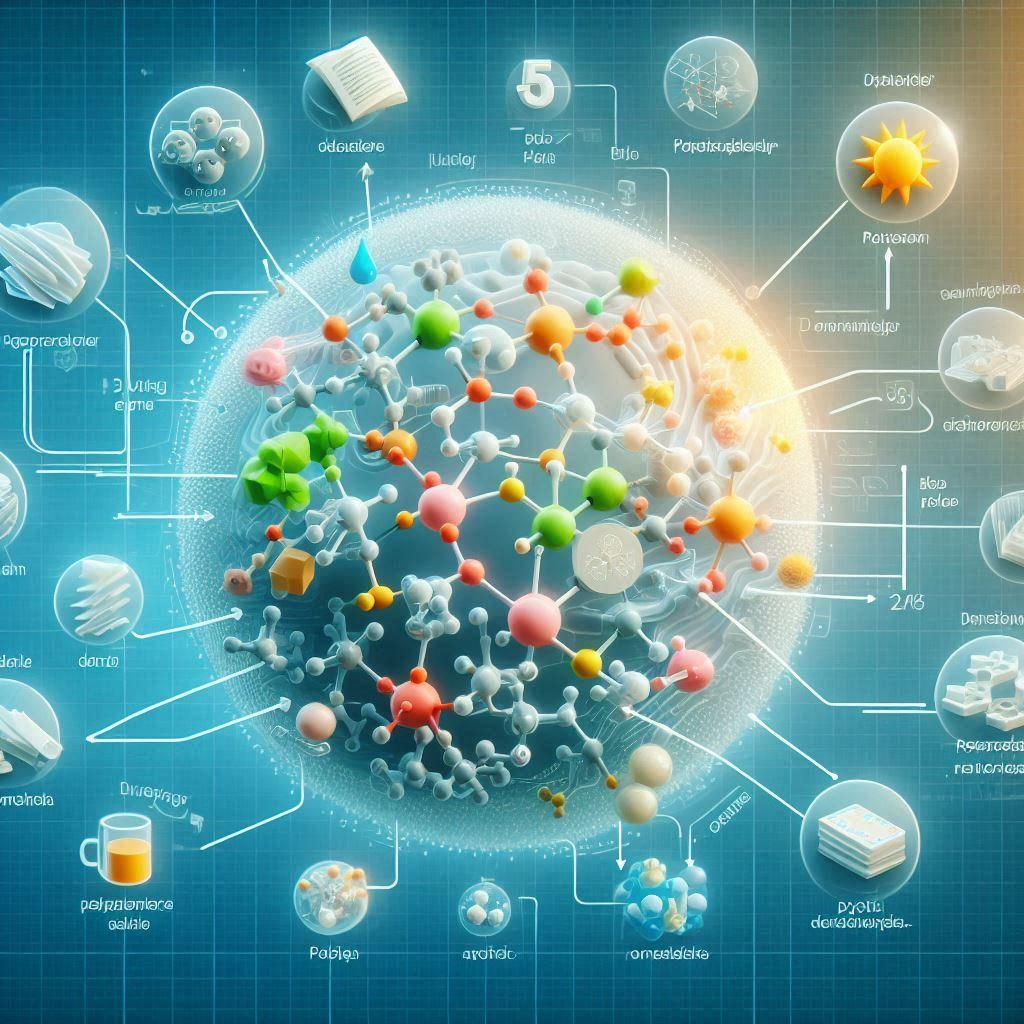
Bio-based Polymers: A Sustainable Alternative
Bio-based polymers are materials derived from renewable biological sources. Unlike traditional plastics made from fossil fuels, these polymers come from plants, microorganisms, and other biomass. They offer an eco-friendly alternative, helping to reduce dependence on nonrenewable resources and lower carbon emissions. With the growing concerns about environmental pollution, bio-based polymers provide a promising solution across various industries.
Many bio-based polymers originate from natural sources such as corn starch, sugarcane, and algae. Corn starch, for example, plays a key role in the production of polylactic acid, or PLA, a biodegradable polymer frequently used in packaging and disposable products. Sugarcane is another valuable resource, used to create bio-polyethylene, or Bio-PE, which shares similar properties with conventional polyethylene but has a significantly lower carbon footprint. More recently, algae have emerged as a promising alternative source, offering a rapidly renewable option that requires minimal resources to cultivate.
Among the many bio-based polymers available today, polylactic acid stands out as one of the most widely recognized and used. PLA is made from fermented plant starch, primarily sourced from corn or sugarcane. It shares many properties with petroleum-based plastics, including clarity, rigidity, and versatility in processing. However, unlike conventional plastics, PLA is biodegradable under industrial composting conditions, breaking down into water and carbon dioxide. Its production generates significantly fewer greenhouse gas emissions, making it an attractive choice for reducing environmental impact.
The advantages of bio-based polymers extend beyond their origins. They contribute to a smaller environmental footprint by relying on renewable resources and emitting fewer greenhouse gases during production. Their sustainability makes them an appealing material choice for industries looking to reduce their ecological impact. In recent years, bio-based polymers have gained popularity in applications such as 3D printing, where materials like PLA offer a practical, biodegradable option. The ability to use these polymers in modern manufacturing further highlights their potential to support sustainability efforts.
The future of bio-based polymers looks promising. As industries continue to seek greener alternatives, the demand for sustainable materials is expected to grow. Innovations in bio-based polymer production and advancements in their applications will further drive their adoption. With their many benefits, including reduced carbon emissions and biodegradability, these polymers have the potential to reshape industries and contribute to a more sustainable future.
Material Innovation and Sustainability ?♻️
3D printing enthusiasts!
I wanted to revisit one of the most exciting trends in additive manufacturing: material innovation and sustainability. ? Over the past couple of years, researchers and companies have made significant advancements in sustainable 3D printing materials, making the industry greener than ever. Let’s dive into the latest innovations shaping the future of eco-friendly 3D printing.
Why Sustainable 3D Printing Matters Now More Than Ever
With climate change and waste reduction at the forefront of global concerns, traditional manufacturing methods that consume vast amounts of resources and generate excessive waste are becoming unsustainable.
How 3D Printing is Leading the Charge:
✅ Uses materials efficiently, reducing waste
✅ Supports local, on-demand production, cutting transportation emissions
✅ Expands recycling possibilities, with more materials being repurposed
✅ Enables biodegradable and bio-based alternatives
The real game-changer? New material innovations that make additive manufacturing (AM) even more sustainable. Let’s explore the coolest developments from recent research.
? The Latest Innovations in Sustainable 3D Printing Materials
1️⃣ Recycled Plastics for 3D Printing Filaments
One of the biggest pushes for sustainability is the use of recycled plastics to create high-quality 3D printing filaments.
? What’s new?
- Researchers are now converting ocean plastic waste into usable 3D printing material (Sharma et al., 2025).
- PET waste (from bottles) is now used to create stronger filaments for FDM printing (Hasheminezhad et al., 2025).
- Companies are improving closed-loop recycling, making it easier to reuse failed prints and leftover filament.
? Impact: Less reliance on virgin plastics, reduced landfill waste, and lower CO₂ emissions! ?
2️⃣ Bio-Based and Biodegradable Materials
The shift toward plant-based and biodegradable materials in 3D printing is accelerating fast!
? Recent breakthroughs:
- Corn starch, algae, and wood pulp are being used to develop stronger bio-composite filaments with enhanced durability (Jung et al., 2025).
- Hemp-based PLA is gaining popularity due to its high strength and biodegradable properties.
- Cellulose-based materials are now being tested for medical applications, showing promise as a sustainable alternative to synthetic polymers.
? Why it matters: These materials break down naturally, reducing microplastic pollution! ?
3️⃣ Sustainable Metal and Ceramic Printing
Beyond polymers, metal and ceramic additive manufacturing is also going green.
? Exciting updates:
- Recycled aluminum and titanium powders are being successfully reused multiple times without performance loss (Papa et al., 2025).
- 3D-printed ceramic geogrids are being developed for sustainable construction applications (Zavaleta et al., 2025).
- Sustainable geopolymers (cement-free alternatives) are gaining traction for 3D-printed housing projects (Sangiorgio et al., 2025).
? Why this is huge: Less material waste, stronger eco-friendly infrastructure, and lower carbon footprints in industrial manufacturing! ?️
?️ Game-Changing Sustainable 3D Printing Technologies
? 1️⃣ Closed-Loop Recycling Systems
Recycling within the 3D printing ecosystem is advancing rapidly! New 3D printers now feature integrated recycling systems that:
✅ Collect and process failed prints and scrap material
✅ Convert old prints into fresh filament or resin
✅ Help users track material usage and optimize print settings
? Why it matters: These closed-loop systems reduce material consumption and waste production, making 3D printing truly circular.
⚡ 2️⃣ Energy-Efficient 3D Printing
✅ Low-energy lasers are being used in SLS (Selective Laser Sintering) and metal AM to cut energy consumption by up to 50%.
✅ Faster print speeds reduce the power demand of long print jobs.
✅ Smart software optimizations are minimizing print failures and energy waste.
? Impact: Lower electricity usage means a smaller carbon footprint for each print!
? 3️⃣ Decentralized, Sustainable Manufacturing
The rise of on-demand, localized 3D printing hubs is transforming supply chains.
? How this is making a difference:
- Companies are 3D-printing spare parts locally, reducing emissions from shipping.
- Disaster relief teams are using 3D-printed medical tools in remote locations, cutting down on waste and logistics (Vinchurkar et al., 2025).
- Construction firms are using 3D-printed raw-earth blocks, eliminating the need for carbon-intensive cement (Siad et al., 2025).
? Why it’s revolutionary: Less overproduction, waste, and emissions—a more sustainable supply chain!
? Industries Leading the Sustainability Revolution
? Aerospace – Using lightweight, high-strength recycled materials to reduce aircraft weight and fuel consumption.
? Healthcare – 3D-printed biodegradable prosthetics and implants are advancing patient care while reducing medical waste.
? Construction – 3D-printed housing using geopolymers, recycled plastics, and natural composites is changing the future of affordable, sustainable housing.
? The Road Ahead for Sustainable 3D Printing
The future of 3D printing is greener than ever! With ongoing material advancements, recycling innovations, and energy-efficient printing, the industry is pushing the boundaries of sustainability.
✨ What to watch for next?
? AI-powered 3D printing waste reduction
? More biodegradable filaments and resins
? Scaling up 3D-printed housing projects
? Let’s embrace this revolution and create a more sustainable future—one 3D print at a time!
References & Further Reading:
- Sharma, A., Kumar, M., & Sharma, A. (2025). Sustainable additive manufacturing: challenges and opportunities of recycling plastic waste for 3D printing filaments.
- Jung, Y.S., Park, J., & Lee, S. (2025). Characterization of thermo-responsive shape memory bio-based thermoplastic polyurethane (SMTPU) for 3D/4D printing applications.
- Siad, H., Lachemi, M., & Sahmaran, M. (2025). An overview of practical challenges and advances in sustainable construction materials.
?♻️ What are your thoughts on these exciting advancements? Let’s discuss in the comments!
